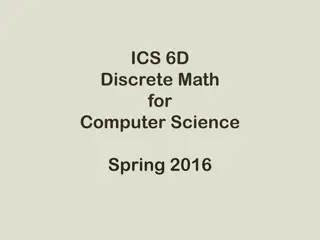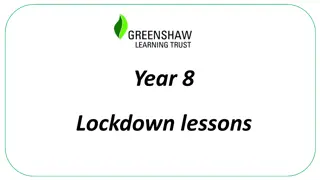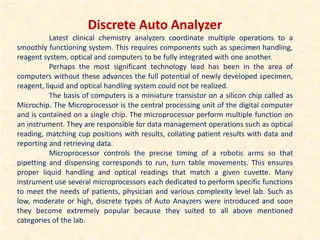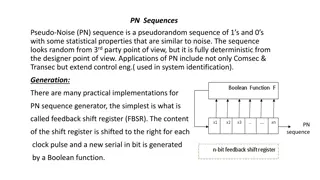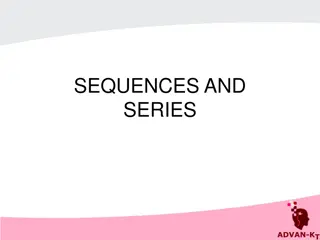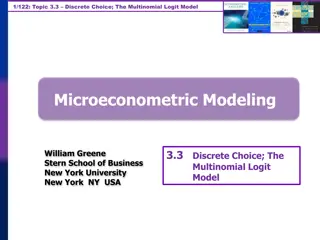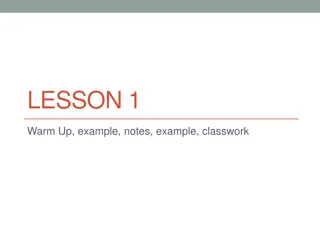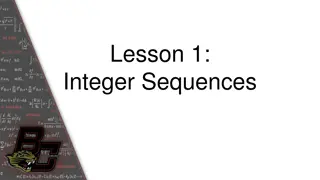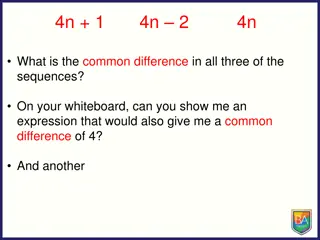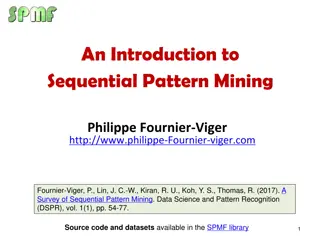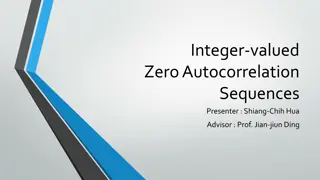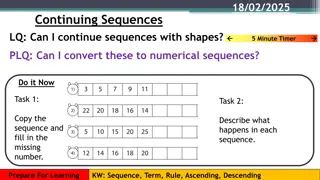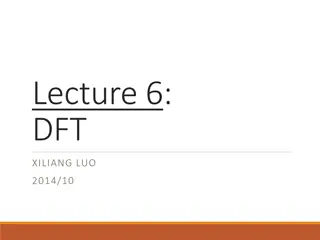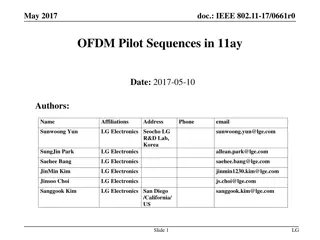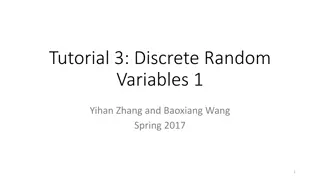Discrete Math for Computer Science Course - ICS 6D, Spring 2016
Prof. Sandy Irani leads the ICS 6D Discrete Math for Computer Science course at UC Irvine. The course covers various topics in discrete mathematics, with lectures on Mondays, Wednesdays, and Fridays. Teaching assistants and readers support the course, which includes interactive activities on zyBook.
9 views • 32 slides
Mastering Sequences in Mathematics
Delve into the world of mathematical sequences with this comprehensive guide. Explore what sequences are, different types like arithmetic and geometric, rules for continuing sequences, methods to find specific terms, and understanding position-to-term rules to solve for nth terms efficiently.
3 views • 17 slides
Advancements in Discrete Auto Analyzers for Clinical Chemistry Operations
Discrete auto analyzers integrate specimen handling, reagent systems, optical components, and computers for streamlined functionality. The innovation in computer technology, particularly microprocessors, has revolutionized these analyzers, enabling precise data management, liquid handling, and optic
5 views • 17 slides
Pseudo-Noise Sequences and Applications
Pseudo-Noise (PN) sequences are deterministic yet appear random, with applications in various fields such as communication security, control engineering, and system identification. Generated using shift registers, they exhibit statistical properties akin to noise. Linear and nonlinear feedback shift
3 views • 19 slides
Sequences and Series
Exploring the concepts of sequences and series in mathematics, including definitions, examples, and exercises on arithmetic sequences, geometric progressions, and general terms. Learn about generating sequences, finding nth terms, common differences, and common ratios in different types of sequences
1 views • 20 slides
Discussion on WLAN Sensing Sequence Design in IEEE 802.11-20/1328r0
This presentation by Rui Du from Huawei discusses the design of sequences for WLAN sensing in IEEE 802.11 standards. It covers topics such as existing sequences, analysis of sequences, ambiguity functions, Golay sequences, and properties adopted for communication sequence design.
4 views • 14 slides
Microeconometric Modeling with Multinomial Logit Model
The topic discusses the Multinomial Logit Model in the context of discrete choice modeling, covering concepts, models, consumer preferences, utility maximization, and implications for discrete choice models. It explores how consumers maximize utility under budget constraints, the need for well-defin
3 views • 58 slides
Discrete Optimization in Mathematical Modeling
Discrete Optimization is a field of applied mathematics that uses techniques from combinatorics, graph theory, linear programming, and algorithms to solve optimization problems over discrete structures. This involves creating mathematical models, defining objective functions, decision variables, and
4 views • 12 slides
Sequences and Patterns in Mathematics
Dive into the world of sequences and patterns with examples and exercises involving identifying patterns, writing formulas, and graphing terms on coordinate planes. Explore different scenarios and learn to express nth terms in sequences. Understand the importance of indexing terms and using proper f
1 views • 48 slides
Integer Sequences and Terms
Explore the concepts of integer sequences, including infinite and finite sequences, terms of a sequence, and nth term formulas. Learn to classify sequences as finite or infinite and find specific terms in a sequence. Gain a comprehensive understanding of notation and terminology used for describing
6 views • 23 slides
Discrete Probability Distributions
Explore the definition of random variables, probability distributions, and three types of discrete distributions - Binomial, Hypergeometric, and Poisson. Learn about the mean, variance, and standard deviation of probability distributions, as well as the difference between discrete and continuous dis
8 views • 32 slides
Sequences and Patterns in Mathematics
Dive into the world of sequences and patterns by exploring expressions, common differences, and nth terms. Discover how to create sequences with specific common differences, identify terms within sequences, and use Venn diagrams to visualize different scenarios. Uncover the rules for constructing nt
4 views • 13 slides
Sequences in Database Management Systems
Sequences in a database are objects that generate unique numeric values automatically. They can be used to create primary key values and improve query performance. By defining sequences using the CREATE SEQUENCE statement in SQL, you can control the generation of sequential numbers with options like
5 views • 41 slides
Recurrence Relations in Discrete Structures
Delve into the world of recurrence relations to solve complex mathematical sequences and patterns in discrete structures. Explore scenarios involving compound interest, Fibonacci sequences, bit strings, and the classic Tower of Hanoi puzzle. Discover the power of recursive definitions and their impl
5 views • 20 slides
Introduction to Sequential Pattern Mining Overview
Discover the concept of sequential pattern mining, a popular data mining task introduced in 1994, with a focus on analyzing discrete sequences to find interesting patterns. Sequential pattern mining involves finding frequent subsequences in sets of discrete sequences, such as items purchased by cust
1 views • 24 slides
Integer-Valued Zero Autocorrelation Sequences
Delve into the realm of integer-valued zero autocorrelation sequences, exploring concepts like periodic sequences, frequency domains, constant amplitudes, and more. Unravel the methods and techniques involved in creating these sequences and their significance in various applications.
2 views • 32 slides
Continuing Sequences with Shapes
In this learning session on 18/02/2025, participants explore sequences with shapes, converting them into numerical sequences, and predicting future patterns. The content includes tasks involving drawing sequences, identifying rules, and predicting shapes based on rules like "Add 2" or "Add 3." Anima
0 views • 12 slides
Finding Nth Term Rule for Sequences
In this learning session on 20/02/2025, students explore how to find and express the nth term rule for sequences. They engage in identifying patterns, determining expressions, and predicting terms in various sequences, fostering a deeper understanding of mathematical rules and patterns. Through inte
0 views • 13 slides
Investigating Recursive Sequences
Today's exploration focuses on understanding and working with recursive sequences in mathematics. Learn about explicit and recursive equations, analyze sequences, and solve problems to enhance your skills in sequences and series.
0 views • 6 slides
Introduction to Discrete Mathematics Course
Discrete Mathematics MACM 101 taught by Binay Bhattacharya covers important themes, goals, and syllabus information. The course includes lectures on Mondays, Wednesdays, and Fridays with additional office hours available for students. Topics like Continuous vs. Discrete Mathematics are explored, emp
2 views • 26 slides
Discrete Fourier Transform: Properties and Sampling Techniques
Explore the properties of Discrete Fourier Transform (DFT) including linearity, circular shift, duality, and circular convolution. Understand the sampling techniques for periodic signals and aperiodic sequences using DFT. Delve into the synthesis and analysis of DFS coefficients as well as the unit-
0 views • 30 slides
Digital Signal Processing and Sequences
Explore the fundamentals of digital signal processing, discrete-time signals, common signal sequences, conversions from analog to digital signals, periodic sequences, and operations on sequences. Learn about scaling, time shifting, reflection, and more in this informative guide.
4 views • 4 slides
Discrete Optimization in Graph Theory
Explore the relationship between counting techniques, graph theory, and discrete optimization, with examples illustrating the transition from counting problems to optimization problems. Learn about applying optimization in scheduling and making graph models, as well as the role of graphs in discrete
3 views • 8 slides
Proposed OFDM Pilot Sequences in IEEE 802.11-17/0661r0 Document
This document from May 2017 suggests frequency domain pilot sequences for EDMG OFDM PHY in IEEE 802.11-17/0661r0. It discusses considerations for pilot sequences in different channel bonding scenarios and emphasizes the importance of mutual orthogonal pilot sequences for robust performance. The pres
3 views • 15 slides
Discrete Random Variables and Associated Probability Functions
Explore the concept of discrete random variables, their associated probability mass functions, and examples of typical discrete random variables like the Binomial and Poisson random variables. Understand the difference between discrete and continuous random variables with practical examples.
2 views • 19 slides
Discrete Structures: Sequences and Sums Analysis
Explore the fundamentals of sequences, including examples such as Fibonacci sequence and evaluation techniques. Learn about arithmetic series, summation, and solve series problems. Discover the formula for sequences and useful sequences to enhance your understanding.
1 views • 33 slides
Discrete Structures: Sequences and Summations Overview
Explore the fundamentals of sequences and summations in discrete structures, including definitions, examples, and properties. Dive into geometric progressions, arithmetic progressions, and series convergence to deepen your understanding.
1 views • 19 slides
Sequences and Series in Algebra 2
Explore the concept of sequences and series in Algebra 2 with examples, rules, and Sigma notation. Learn how to define, write rules, graph, and find the sum of sequences and series using Sigma notation and summation. Discover the patterns, rules, and methods to work with sequences and series effecti
5 views • 35 slides
Number Sequences: Patterns & Examples
Delve into the concept of number sequences, exploring the patterns and examples behind their orderly arrangement. Uncover the logic behind sequences like 10, 20, ?, 30 and 3, 6, 9, 12, 15, revealing the methodical progression of numbers in a sequence. Decode the mystery behind sequences such as 25,
0 views • 4 slides
Exploring Limiting Values in Sequences
Dive into the world of sequences and explore the concept of limiting values, discovering patterns and reflecting on challenging sequences. Engage with intriguing numerical patterns and sharpen your mathematical skills as you unravel the mysteries hidden within sequences.
0 views • 4 slides
Utilizing Golay Sequences for Radar and Sensing Applications
Explore how Golay sequences can be effectively used for radar and sensing applications, particularly in the context of IEEE 802.11 standards. Learn about the ambiguity functions associated with Golay sequences and their applications in channel estimation and detection sequences. Discover the benefit
0 views • 11 slides
Exploring Linear Sequences: First Terms and Next Steps
Dive into the world of linear sequences with this interactive guide. Discover examples of ascending and descending sequences, find the next terms in various sequences, and explore the patterns hidden within numbers. Test your knowledge with exercises to identify first terms and constant differences
1 views • 15 slides
Introduction to Discrete Mathematics: MACM 101 Overview
Discrete Mathematics course MACM 101 with Lecturer Binay Bhattacharya covers topics such as continuous vs. discrete math, course information, grading criteria, and more. The course emphasizes mathematical techniques for discrete math and its relevance in computer science. With insights into lectures
1 views • 25 slides
IEEE 802.11-20/0782r0 EHT-STF Sequences for 240/160+80/320/160+160 MHz
Explore the proposal of 1x/2x EHT-STF sequences designed based on 80MHz/160MHz HE-STF sequences with additional phase rotation for improved PAPR. Comparison of PAPRs with data part for feasibility verification. Optimization of coefficients and utilization of 80HES for beneficial implementation and P
1 views • 27 slides
Understanding Sequences and Summations in Computer Science
Explore the concepts of sequences and summations in computer science, including specifying sequences, closed forms of summations, special sequences like geometric and arithmetic progressions, identifying sequence formulas, and solving sequence problems. Dive into the world of ordered lists of elemen
2 views • 19 slides
Discrete Mathematics for Computer Science: Overview and Course Details
Explore the course "Discrete Mathematics for Computer Science" instructed by Dr. Abdelouahid Derhab. This introductory course covers foundational topics such as sets, sequences, logic, relations, counting, graphs, and trees. Students will develop problem-solving skills and discover how discrete math
1 views • 8 slides
Mastering Recursive Rules for Sequences in Mathematics
Discover how to define sequences recursively, write recursive rules for given sequences, and translate from recursive rules to explicit rules in this comprehensive guide. Dive into the world of sequences and enhance your mathematical skills.
2 views • 18 slides
Real Analysis Part II: Sequences and Bounds
Explore the concepts of real sequences, range of sequences, constant sequences, bounds, supremum, and infimum in the study of real analysis. This course is designed for students pursuing a Bachelor's degree in Mathematics at the University of Rajasthan, Jaipur. Dive into the fundamentals of sequence
1 views • 18 slides
Optimal EHT-STF Sequences for IEEE 802.11-20/0782r2 Document
Explore the proposed 1x/2x EHT-STF sequences for 240/160+80 MHz in the IEEE 802.11-20/0782r2 document. These sequences are designed based on HE-STF sequences with additional phase rotation to enhance PAPR. The coefficients are optimized for improved feasibility, and comparisons with data parts are c
0 views • 29 slides
Golay Sequences for Radar and Sensing Applications
Explore how Golay sequences can be utilized for radar and sensing applications, discussing their ambiguity function and practical implementations. Learn about the advantages of using Golay sequences and their role in radar systems. Discover how Golay sequences fit into IEEE 802.11-20 standards, part
0 views • 10 slides
